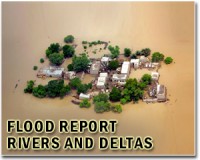 |
Teresopolis, Brazil (AFP) Jan 13, 2011 Scenes of horror unfolded near Rio Thursday, after torrents of mud and water swept down crowded hillsides killing more than 430 people in Brazil's worst natural disaster in decades. Walls of thick, muddy gunge cascaded past apartment blocks in several towns, flowing into single-story homes and overturning cars as they surged down the hills sweeping along everything in their path. "I thought I was going to die," said Ilair Pereira de Souza, a 53-year-old woman who had a miraculous escape when neighbors on a nearby balcony threw her a rope. "Help me, help me," she pleaded, in scenes replayed throughout the day on Brazilian television. She grabbed for the rope, and disappeared underneath the muddy waters, before reappearing, clinging to the slim lifeline, but without her dog Beethoven, which she had been clutching in her arms. "If I had tried to save him, I would have died. The poor thing. He stayed for a moment looking me in the eyes, and then he was swept away." Freakish storms early Wednesday in the mountainous area just north of Rio de Janeiro dumped the equivalent of a month's rain in just a few hours, sending mudslides slicing through towns and hamlets, destroying homes, roads and bridges and knocking out telephone and power lines. At least 432 people have died, according to local officials and media in the worst affected towns of Novo Friburgo, Teresopolis and Petropolis. President Dilma Rousseff, clad in black rubber boots, walked the mud-covered cobblestone streets of Novo Friburgo, where 201 deaths were recorded, took a helicopter tour of the disaster zone and pledged "strong action" by the government. The death toll was expected to rise further as rescuers arrived in remote hamlets, many cut off to all but helicopter access. "One woman tried to save her children, but her two-month-old baby was carried away by a torrent like a doll," sobbed Angela, a 55-year-old resident of Teresopolis. Tropical rains, common at this time of year, intensified as a cold front moved in, unleashing the tragedy before dawn, while families slept. "In eight hours... it rained as much as for the entire month," said Paulo Canedo, a hydrologist at the Federal University of Rio de Janeiro. The deluge "caused avalanches of rocks and soil that carried everything down with them, picking up houses," he said. As weather forecasters warned of more rain in the hours and days ahead, rescuers aided by desperate residents clawed through rubble and mud looking for survivors or bodies. GloboNews television said 175 people had died in Teresopolis, while officials in Petropolis counted 39 dead. Another 17 bodies were discovered Thursday in a village called Sumidouro. Churches and police stations were turned into makeshift morgues, the smell of decomposing corpses heavy in the warm air. Thousands of survivors took refuge in shelters. But among the despair, were a few triumphs. Firemen managed to save a six-month-old baby and the 25-year-old father who had been buried in mud in each others' arms. The father, Wellington, told the G1 news website that his wife and his mother-in-law died when mud swamped their home. The scenes of crumbled towns and the stench of death, though, transformed the Serrana region, a popular historical getaway for wealthy Rio residents seeking cooler temperatures. The disaster also provided the first big test for Rousseff, who only took power on January 1. Her government has released 470 million dollars in initial emergency aid and sent seven tons of medical supplies. But her failure to make any public statement or emotional display immediately following the catastrophe contrasted with the style of her predecessor, Luiz Inacio Lula da Silva, who cultivated a gruff and gregarious father image in public. The last major natural disaster in Brazil was in March 1967, when mudslides killed 300 people in a coastal town called Caraguatatuba, Brazilian media said. By way of comparison, Brazil recorded 473 deaths for all of last year from heavy rains.
Share This Article With Planet Earth
Related Links Bringing Order To A World Of Disasters When the Earth Quakes A world of storm and tempest
 Australia's Brisbane besieged by major flood crisis
Australia's Brisbane besieged by major flood crisisBrisbane, Australia (AFP) Jan 12, 2011 Australia's third-biggest city Brisbane was besieged Wednesday by once-in-a-century floods that could hit up to 20,000 homes, as fears grew up to 25 people were killed by raging torrents. Thousands of people took refuge with friends and central districts were eerily quiet as the river city of two million prepared for its worst deluge since 1893, as floods spread across vast areas of Australi ... read more |
|
| The content herein, unless otherwise known to be public domain, are Copyright 1995-2010 - SpaceDaily. AFP and UPI Wire Stories are copyright Agence France-Presse and United Press International. ESA Portal Reports are copyright European Space Agency. All NASA sourced material is public domain. Additional copyrights may apply in whole or part to other bona fide parties. Advertising does not imply endorsement,agreement or approval of any opinions, statements or information provided by SpaceDaily on any Web page published or hosted by SpaceDaily. Privacy Statement |